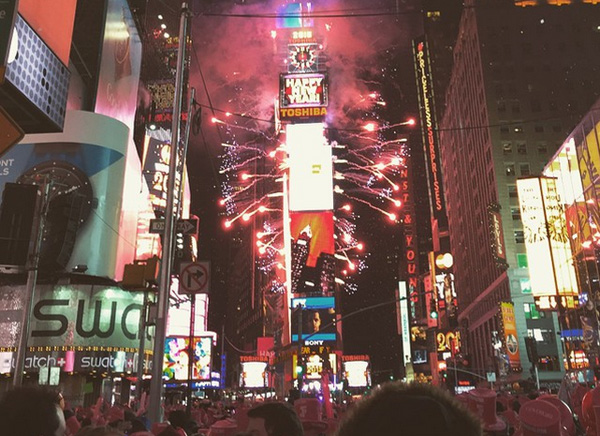Celebrating New Year in New York
01/01/2015
The build up to New Year is traditionally saturated with summaries: top googled words, who died, who should’ve died, memorable sporting victories, worst selling, best selling, internet wins, Twitter fails, popular destinations, favourite gadgets…what to look forward to, forecasts for the next 12 months…and so on.
This New Year will be my second New Year in New York, but the first as a resident. The experience here is similar in many ways to that in London; very large numbers of people, predominantly tourists and non-indigenous types, gather in a central location in the freezing cold, while locals are either at a private party or in a totally different city altogether. Instead of gathering in Trafalgar Square in London, everyone in New York flocks to Times Square to watch a ball drop. Over one million people make the pilgrimage every year and even as I write this, just after lunch, on New Year’s Eve, the news channels on TV are showing a seething mass of people staking their claim on a good spot.
The way it works is like this: obviously the whole area is closed to traffic and each block is sectioned off, so you can go as far up as the barrier, but if you want to move forward past that, you have to walk about two or three blocks along away from the crowd, then a couple of blocks forward, then along again toward the crowd until the density increases and you find yourself in the thick of it once more.
The first time I was in New York I tried this. It was back in December 1997 and I was with the girl I was dating at the time. We fought our way through the heaving crowds to get to the front of that block, pressed up against the police barrier and stood there in the freezing cold. On the other side of the street only a few metres away, was a McDonalds, a place where I could purchase coffee and thus fight off frostbite for perhaps another hour. I politely asked a police officer if I could quickly nip under the barrier and grab a coffee…and he gave me a look like I’d just pointed a gun in his face. After a few seconds of staring at me through mirrored sunglasses he said I’d have to walk two blocks over, two down and two back to get and then make my way to the back, which is where the McDonalds was. I smiled, said thank you and didn’t bother.
Then I asked the same unimpressed police officer where this infamous ball was. This question resulted in him actually removing his mirrored sunglasses so he could stare at me properly. “Are you blind son?” He asked. He pointed to this tiny golf ball-sized object on top of a cocktail stick far away in the distance and said, “See?!”
“I thought it would be bigger.” I replied, unimpressed.
Today, the infamous ‘Times Square Ball’ is 12 feet in diameter and weighs six tons. In my defence, in 1997 it was still only five feet in diameter.

Located on the roof of One Times Square, the ball is a prominent part of New York’s New Year’s Eve celebration, colloquially known as the ‘ball drop’, where it descends 141 feet in 60 seconds down a specially designed flagpole, beginning at 11:59pm ET, and resting at midnight to signal the start of the new year.
All these people are here, freezing their butts off, to watch that tiny ball..? Nuts to this, I thought. So we raced home, ate room service basking in the warmth of the hotel, watched the ball drop on TV and frolicked about under the sheets. Perfect New Year.
So, why a ball? It’s based on a large painted wooden or metal ball that used to drop at a predetermined time to enable sailors to check their marine chronometers from their boats offshore. Accurate timekeeping is one way of enabling mariners to determine their longitude at sea.
So-called ‘timeball stations’ set their clocks according to transit observations of the positions of the sun and stars. Originally they either had to be stationed at the observatory itself, or had to keep a very accurate clock at the station which was set manually to observatory time. The first timeball was erected at Portsmouth, England in 1829 by its inventor Robert Wauchope, a Captain in the Royal Navy. Others followed in the major ports of the UK (including Liverpool) and around the maritime world. One was installed in 1833 at the Greenwich Observatory by Astronomer Royal John Pond, and the timeball has dropped at 1pm every day since then. Wauchope submitted his scheme to American and French ambassadors when they visited England. The US Naval Observatory was established in Washington DC and the first American timeball went into service in 1845.
Timeballs are usually dropped at 1pm (although in the USA they were dropped at noon). They were raised half way about 5 minutes earlier to alert the ships, then with 2–3 minutes to go they were raised the whole way. The time was recorded when the ball began descending, not when it reached the bottom. With the commencement of radio time signals from 1924, time-balls gradually became obsolete and many were demolished in the 1920s.
Of course if I’d wanted to go and see it this year, it would be safe to say that a) I was out of my mind and b) I should have left five hours ago. I made the effort once, I have an idea of the suffering involved, I don’t think I need to do it again. Just like you’d never catch me standing around Trafalgar Square catching pneumonia and waiting for Big Ben to chime midnight.